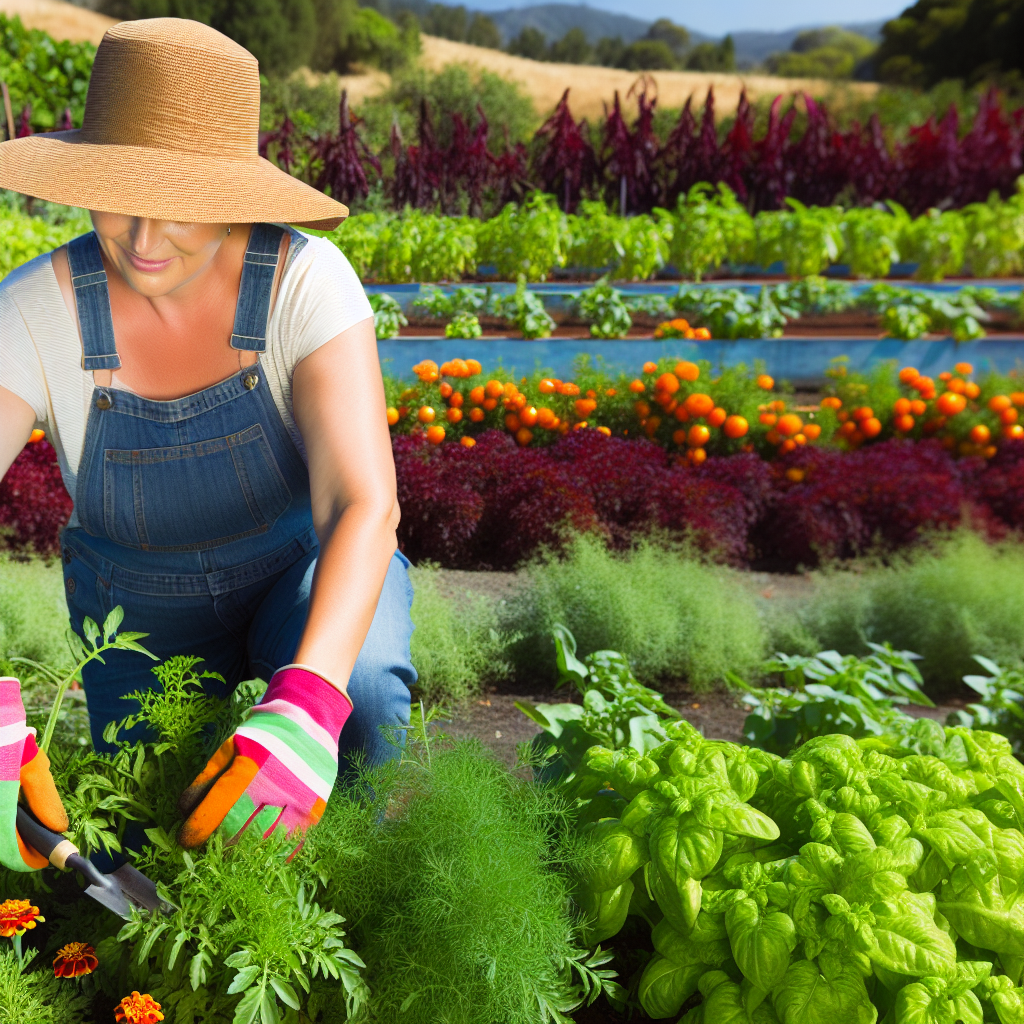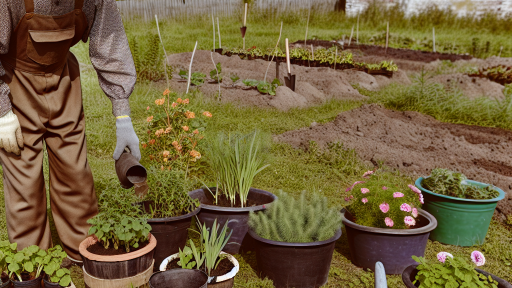Introduction to Companion Planting
Definition of Companion Planting
Companion planting involves growing different plants together for mutual benefit.
This technique enhances growth, repels pests, and increases yields.
It recognizes that certain plants thrive better in the presence of others.
Benefits of Companion Planting
Companion planting offers multiple advantages to gardeners and farmers.
- It can improve plant health and vitality.
- It helps maximize space in edible landscapes.
- This method attracts beneficial insects and pollinators.
Moreover, companion planting provides natural pest control.
For example, marigolds deter harmful nematodes and certain insects.
Thus, gardeners can reduce reliance on chemical pesticides.
Enhancing Flavor and Nutrition
Some plants can even enhance the flavor of nearby crops.
Basil planted with tomatoes is a popular example.
This pairing not only increases flavor but may boost nutritional content as well.
Creating a Balanced Ecosystem
Implementing companion planting fosters a balanced garden ecosystem.
This arrangement promotes healthy soil and biodiversity.
As a result, the overall resilience of the garden improves.
Such biodiversity supports various life forms, from microorganisms to birds.
Practical Considerations
When choosing companion plants, consider their growth habits.
Transform Your Agribusiness
Unlock your farm's potential with expert advice tailored to your needs. Get actionable steps that drive real results.
Get StartedCompatibility matters; some plants may compete for nutrients.
Researching suitable pairings will help you achieve the best results.
Historical Context of Companion Planting in Agriculture
Origins of Companion Planting
Companion planting dates back thousands of years in various cultures.
Farmers in ancient civilizations practiced these techniques for benefits.
For instance, the Native Americans utilized the “Three Sisters” method.
This method paired corn, beans, and squash for mutual benefits.
Traditional Practices Across Cultures
Historically, different cultures developed their own companion planting methods.
In Europe, the French utilized plants like marigold to deter pests.
Similarly, in Asia, farmers combined rice with legumes for nutrient enhancement.
These diverse practices showcased local ecological knowledge.
Scientific Understanding and Development
With time, scientific research validated many traditional practices.
Modern agriculture began to recognize the importance of biodiversity.
Studies showed that companion plants can improve soil health and pest control.
As a result, contemporary gardening incorporates these ancient wisdoms.
Contemporary Applications
Today, companion planting plays a role in sustainable agriculture.
Farmers aim for increased crop yields and reduced chemical dependency.
Nutrition-focused urban gardening also embraces this practice.
Gardeners use companion plants to create thriving edible landscapes.
Key Principles of Companion Planting for Edible Landscapes
Understanding Companion Planting
Companion planting involves growing different plants together for mutual benefits.
This practice enhances growth, nutrient uptake, and pest management.
Moreover, it can increase yields and promote plant health.
Types of Companion Planting
Companion planting can be categorized into various types.
- Mutualism encourages plants to support each other’s growth.
- Allelopathy involves one plant inhibiting another’s growth.
- Providing habitats for beneficial insects can enhance pollination.
Benefits of Companion Planting
Companion planting offers numerous benefits for edible landscapes.
- It helps repel pests through natural deterrents.
- Plants can improve soil health through nitrogen fixation.
- Companion planting also leads to better use of space.
Choosing Compatible Plants
Choose plants that complement each other’s growth habits.
Showcase Your Farming Business
Publish your professional farming services profile on our blog for a one-time fee of $200 and reach a dedicated audience of farmers and agribusiness owners.
Publish Your ProfileFor example, pairing tomatoes with basil promotes growth and flavor.
Additionally, planting carrots near onions can deter pests.
Research local growing conditions to select the best companions.
Planning Your Edible Landscape
Begin by designing a layout for your edible landscape.
Consider sunlight, water, and soil needs for each species.
Incorporate diverse plant heights and root structures to maximize space.
Use vertical gardening techniques to save space and improve yields.
Maintaining Your Companion Plantings
Regular maintenance is crucial for successful companion planting.
Monitor plant health and adjust placements as necessary.
Water and feed plants according to their specific needs.
Furthermore, watch for pest populations and take action early.
Explore Further: Seasonal Seed Saving Guide For Farmers
Selecting Companion Plants: Best Pairings for Vegetables and Herbs
Understanding Companion Planting
Companion planting enhances garden productivity and health.
This practice involves pairing specific plants for mutual benefits.
Healthy plant relationships improve nutrient uptake and pest control.
Essential Nutrient Companions
Some plants provide nutrients that others crave.
For instance, legumes enrich the soil with nitrogen.
Pairing beans with corn creates a beneficial ecosystem.
Pest Control Partnerships
Certain plant combinations deter pests naturally.
Marigolds can repel nematodes and other harmful insects.
Planting basil near tomatoes enhances growth and flavor.
Herbs That Benefit Vegetables
Herbs can attract beneficial insects to the garden.
For example, dill helps attract predatory wasps.
Additionally, oregano can deter unwanted cabbage worms.
Choosing the Right Pairings
Selecting compatible plants requires knowledge of their needs.
Consider sunlight, water, and space requirements when pairing.
For shade lovers, plant lettuce with taller crops like tomatoes.
Popular Companion Planting Combinations
- Carrots pair well with onions to repel pests.
- Cucumbers benefit from the shade provided by corn.
- Radishes can help deter cucumber beetles when planted together.
Seasonal Considerations
Timing is crucial when implementing companion planting.
Spring plantings differ from summer and fall combinations.
For instance, consider early-season crops like peas with spinach.
Experimenting in Your Garden
Every garden offers unique conditions for plants.
Start by conducting small experiments with different pairings.
Observe plant health and yields to determine successful combinations.
See Related Content: Scaling Your Mushroom Farm: Tips and Tricks
Benefits of Companion Planting
Pest Control
Companion planting helps suppress pests naturally.
Certain plants repel insects that threaten crops.
For example, marigolds deter nematodes and aphids.
Additionally, basil can repel mosquitoes and flies.
Planting garlic alongside vegetables offers many benefits.
Garlic contains sulfur which deters a variety of pests.
Showcase Your Farming Business
Publish your professional farming services profile on our blog for a one-time fee of $200 and reach a dedicated audience of farmers and agribusiness owners.
Publish Your ProfileThis strategy creates a healthier growing environment.
Overall, companion planting minimizes the need for chemical pesticides.
Improved Growth
Companion planting enhances nutrient uptake in the soil.
Some plants can provide shade, benefiting their neighbors.
For instance, corn offers support for climbing beans.
Beans, in turn, fix nitrogen in the soil.
This relationship enriches the surrounding plants.
Moreover, diverse plant groups promote healthy soil microbiomes.
Thus, plants can grow stronger and more resilient.
Further, companion planting can increase overall yield.
Choosing the right combinations leads to abundant harvests.
Explore Further: Starting Your Own Organic Small-Scale Farm
Creating an Edible Landscape: Planning and Design Tips
Understanding the Concept
An edible landscape blends beauty with functionality.
This design allows you to grow food while enhancing your outdoor space.
Incorporating trees, shrubs, and flowers promotes biodiversity.
Moreover, it provides fresh produce at your fingertips.
Assessing Your Space
Start by evaluating your available outdoor space.
Take note of sunlight, soil type, and available water sources.
This analysis helps in selecting the right plants.
Consider how much space you have for both growing and walking.
Selecting Suitable Plants
Choose plants that thrive in your local climate.
Include a mix of fruits, vegetables, and herbs.
Consider perennial plants for low-maintenance growth.
Additionally, incorporate companion plants for pest control and nutrient benefits.
Designing for Aesthetics and Functionality
Plan a layout that enhances visual appeal and accessibility.
Use pathways to separate different areas and ease access.
Group plants by height, color, and growing requirements.
This organization will create a harmonious look in your landscape.
Incorporating Vertical Elements
Utilize vertical gardening techniques to maximize space.
Install trellises or vertical planters for climbing plants.
These features add visual interest and save ground space.
Moreover, vertical gardens can improve air circulation and sunlight exposure.
Planning for Seasonal Changes
Choose plants that offer year-round interest.
Incorporate spring blooms, summer fruits, and autumn foliage.
This diversity ensures a dynamic landscape throughout the seasons.
Contemplate seasonal planting schedules to maintain productivity.
Maintaining Your Edible Landscape
Regular maintenance is essential for a thriving garden.
Water your plants consistently, especially during dry spells.
Mulching can help retain moisture and suppress weeds.
Additionally, watch for pests and diseases to ensure plant health.
Showcase Your Farming Business
Publish your professional farming services profile on our blog for a one-time fee of $200 and reach a dedicated audience of farmers and agribusiness owners.
Publish Your ProfileEnjoying the Harvest
Finally, involve family and friends in the harvesting process.
This communal effort enhances the joy of gardening.
Celebrate your harvest with cooking or sharing meals together.
Ultimately, your edible landscape serves as both food source and gathering space.
See Related Content: Edible Landscaping Layouts for Small Farms

Common Companion Planting Mistakes to Avoid
Ignoring Plant Compatibility
Many gardeners overlook the importance of plant compatibility.
Not every plant thrives when paired together.
For instance, beans and onions do not grow well together.
Researching compatible plants enhances your garden’s productivity.
Overcrowding the Garden
Another common mistake is overcrowding plants.
Plants need adequate space to grow and receive sunlight.
Poor spacing can lead to competition for nutrients.
Ensure to follow recommended spacing guidelines for each species.
Neglecting Soil Health
Soil health is vital for successful companion planting.
Many gardeners forget to test and amend their soil properly.
Healthy soil promotes strong root systems and plant growth.
Regularly amend your soil with organic matter to improve fertility.
Not Considering Growth Habits
Growth habits impact plant interactions significantly.
Some plants grow tall and shade others beneath them.
Understanding each plant’s growth habit prevents competition for light.
Pay attention to height and spread when planning your layout.
Choosing Wrong Plant Varieties
Choosing the wrong varieties can hinder your garden’s success.
For instance, specific varieties of tomatoes may not do well with peppers.
Check for any unique requirements of the varieties you select.
Consult local gardening resources to find well-suited varieties.
Ignoring Pest and Disease Interactions
Pest and disease interactions can disrupt your garden.
Some plants attract specific pests that can harm others.
Identify pest-resistant varieties to minimize damage.
Incorporate beneficial insects to manage pest populations effectively.
Case Studies: Successful Companion Planting in Urban Gardens
Introduction to Companion Planting
Companion planting enhances garden productivity and health.
This practice involves strategically placing plants to benefit each other.
Moreover, it can deter pests and improve soil fertility.
Example of Companion Planting in Action
In urban gardens, companion planting yields impressive results.
One notable case is the partnership of tomatoes and basil.
Basil repels harmful insects and enhances tomato flavor.
Residents of Greenfield City have reported higher yields using this method.
Community Gardens Leading the Way
Local community gardens adopt companion planting strategies effectively.
At the Harmony Garden, members plant marigolds with their vegetables.
Marigolds attract beneficial insects that control pests naturally.
The Role of Education and Workshops
Educational workshops on companion planting increase awareness.
Showcase Your Farming Business
Publish your professional farming services profile on our blog for a one-time fee of $200 and reach a dedicated audience of farmers and agribusiness owners.
Publish Your ProfileThe Urban Garden Project hosts monthly sessions for community members.
Participants learn about plant relationships and garden design.
Hands-on experiences engage attendees and promote sustainability.
Challenges Faced and Overcome
Urban gardeners encounter unique challenges with companion planting.
Space constraints often limit plant combinations.
Nevertheless, innovative solutions emerge, maximizing limited areas.
Future Prospects for Urban Gardening
The future looks bright for companion planting in urban settings.
Increased demand for local food motivates more gardeners to participate.
Ultimately, successful partnerships among plants bring multiple benefits.
Resources for Further Learning
Books
Books provide valuable insights into companion planting strategies.
Look for titles by experts in sustainable gardening.
Some recommended books include:
- The Vegetable Gardener’s Bible by Ed Smith.
- Carrots Love Tomatoes by Louise Riotte.
- Plant Companion Gardening by Rachael T. Freedman.
Websites
Many websites offer a wealth of information on companion planting.
The following websites are excellent resources:
- The Old Farmer’s Almanac, which offers planting guides.
- Gardener’s Supply Company, featuring articles on sustainable practices.
- The USDA’s National Organic Program, providing regulatory information.
Community Groups
Connecting with local gardening groups enhances your knowledge.
Consider joining these community organizations:
- Local garden clubs for shared resources and events.
- Community-supported agriculture (CSA) programs.
- Online forums like GardenWeb to discuss ideas.
Additional Resources
Move Over Roses, Make Room for Fennel | Edible East End
Raghav Kumar on LinkedIn: This is my client Anitha Aunty who runs …




